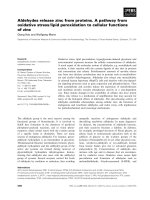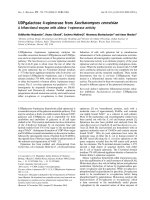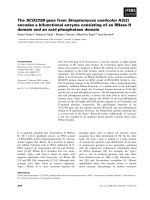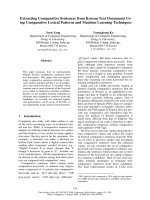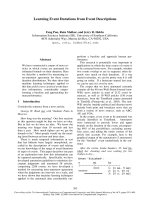Báo cáo khoa học: "Learning Common Grammar from Multilingual Corpus" potx
Bạn đang xem bản rút gọn của tài liệu. Xem và tải ngay bản đầy đủ của tài liệu tại đây (1002.25 KB, 5 trang )
Proceedings of the ACL 2010 Conference Short Papers, pages 184–188,
Uppsala, Sweden, 11-16 July 2010.
c
2010 Association for Computational Linguistics
Learning Common Grammar from Multilingual Corpus
Tomoharu Iwata Daichi Mochihashi
NTT Communication Science Laboratories
2-4 Hikaridai, Seika-cho, Soraku-gun, Kyoto, Japan
{iwata,daichi,sawada}@cslab.kecl.ntt.co.jp
Hiroshi Sawada
Abstract
We propose a corpus-based probabilis-
tic framework to extract hidden common
syntax across languages from non-parallel
multilingual corpora in an unsupervised
fashion. For this purpose, we assume a
generative model for multilingual corpora,
where each sentence is generated from a
language dependent probabilistic context-
free grammar (PCFG), and these PCFGs
are generated from a prior grammar that
is common across languages. We also de-
velop a variational method for efficient in-
ference. Experiments on a non-parallel
multilingual corpus of eleven languages
demonstrate the feasibility of the proposed
method.
1 Introduction
Languages share certain common proper-
ties (Pinker, 1994). For example, the word order
in most European languages is subject-verb-object
(SVO), and some words with similar forms are
used with similar meanings in different languages.
The reasons for these common properties can be
attributed to: 1) a common ancestor language,
2) borrowing from nearby languages, and 3) the
innate abilities of humans (Chomsky, 1965).
We assume hidden commonalities in syntax
across languages, and try to extract a common
grammar from non-parallel multilingual corpora.
For this purpose, we propose a generative model
for multilingual grammars that is learned in an
unsupervised fashion. There are some computa-
tional models for capturing commonalities at the
phoneme and word level (Oakes, 2000; Bouchard-
C
ˆ
ot
´
e et al., 2008), but, as far as we know, no at-
tempt has been made to extract commonalities in
syntax level from non-parallel and non-annotated
multilingual corpora.
In our scenario, we use probabilistic context-
free grammars (PCFGs) as our monolingual gram-
mar model. We assume that a PCFG for each
language is generated from a general model that
are common across languages, and each sentence
in multilingual corpora is generated from the lan-
guage dependent PCFG. The inference of the gen-
eral model as well as the multilingual PCFGs can
be performed by using a variational method for
efficiency. Our approach is based on a Bayesian
multitask learning framework (Yu et al., 2005;
Daum
´
e III, 2009). Hierarchical Bayesian model-
ing provides a natural way of obtaining a joint reg-
ularization for individual models by assuming that
the model parameters are drawn from a common
prior distribution (Yu et al., 2005).
2 Related work
The unsupervised grammar induction task has
been extensively studied (Carroll and Charniak,
1992; Stolcke and Omohundro, 1994; Klein and
Manning, 2002; Klein and Manning, 2004; Liang
et al., 2007). Recently, models have been pro-
posed that outperform PCFG in the grammar in-
duction task (Klein and Manning, 2002; Klein and
Manning, 2004). We used PCFG as a first step
for capturing commonalities in syntax across lan-
guages because of its simplicity. The proposed
framework can be used for probabilistic grammar
models other than PCFG.
Grammar induction using bilingual parallel cor-
pora has been studied mainly in machine transla-
tion research (Wu, 1997; Melamed, 2003; Eisner,
2003; Chiang, 2005; Blunsom et al., 2009; Sny-
der et al., 2009). These methods require sentence-
aligned parallel data, which can be costly to obtain
and difficult to scale to many languages. On the
other hand, our model does not require sentences
to be aligned. Moreover, since the complexity of
our model increases linearly with the number of
languages, our model is easily applicable to cor-
184
pora of more than two languages, as we will show
in the experiments. To our knowledge, the only
grammar induction work on non-parallel corpora
is (Cohen and Smith, 2009), but their method does
not model a common grammar, and requires prior
information such as part-of-speech tags. In con-
trast, our method does not require any such prior
information.
3 Proposed Method
3.1 Model
Let X = {X
l
}
l∈L
be a non-parallel and non-
annotated multilingual corpus, where X
l
is a set
of sentences in language l, and L is a set of lan-
guages. The task is to learn multilingual PCFGs
G = {G
l
}
l∈L
and a common grammar that gen-
erates these PCFGs. Here, G
l
= (K, W
l
, Φ
l
)
represents a PCFG of language l, where K is a
set of nonterminals, W
l
is a set of terminals, and
Φ
l
is a set of rule probabilities. Note that a set of
nonterminals K is shared among languages, but
a set of terminals W
l
and rule probabilities Φ
l
are specific to the language. For simplicity, we
consider Chomsky normal form grammars, which
have two types of rules: emissions rewrite a non-
terminal as a terminal A → w, and binary pro-
ductions rewrite a nonterminal as two nontermi-
nals A → BC, where A, B, C ∈ K and w ∈ W
l
.
The rule probabilities for each nonterminal
A of PCFG G
l
in language l consist of: 1)
θ
Al
= {θ
lAt
}
t∈{0,1}
, where θ
lA0
and θ
lA1
repre-
sent probabilities of choosing the emission rule
and the binary production rule, respectively, 2)
φ
lA
= {φ
lABC
}
B,C∈K
, where φ
lABC
repre-
sents the probability of nonterminal production
A → BC, and 3) ψ
lA
= {ψ
lAw
}
w∈W
l
, where
ψ
lAw
represents the probability of terminal emis-
sion A → w. Note that θ
lA0
+ θ
lA1
= 1, θ
lAt
≥ 0,
B,C
φ
lABC
= 1, φ
lABC
≥ 0,
w
ψ
lAw
= 1,
and ψ
lAw
≥ 0. In the proposed model, multino-
mial parameters θ
lA
and φ
lA
are generated from
Dirichlet distributions that are common across lan-
guages: θ
lA
∼ Dir(α
θ
A
) and φ
lA
∼ Dir(α
φ
A
),
since we assume that languages share a common
syntax structure. α
θ
A
and α
φ
A
represent the param-
eters of a common grammar. We use the Dirichlet
prior because it is the conjugate prior for the multi-
nomial distribution. In summary, the proposed
model assumes the following generative process
for a multilingual corpus,
1. For each nonterminal A ∈ K:
α
α
φ
A
a,b
a,b
|L|
θ
A
α
lA
lA
|K|
φ φ
θ
ψ
lA
|L|
z
1
z
2
z
3
x
2
x
3
φ
ψ
θ
θ
Figure 1: Graphical model.
(a) For each rule type t ∈ {0, 1}:
i. Draw common rule type parameters
α
θ
At
∼ Gam(a
θ
, b
θ
)
(b) For each nonterminal pair (B, C):
i. Draw common production parameters
α
φ
ABC
∼ Gam(a
φ
, b
φ
)
2. For each language l ∈ L:
(a) For each nonterminal A ∈ K:
i. Draw rule type parameters
θ
lA
∼ Dir(α
θ
A
)
ii. Draw binary production parameters
φ
lA
∼ Dir(α
φ
A
)
iii. Draw emission parameters
ψ
lA
∼ Dir(α
ψ
)
(b) For each node i in the parse tree:
i. Choose rule type
t
li
∼ Mult(θ
lz
i
)
ii. If t
li
= 0:
A. Emit terminal
x
li
∼ Mult(ψ
lz
i
)
iii. Otherwise:
A. Generate children nonterminals
(z
lL(i)
, z
lR(i)
) ∼ Mult(φ
lz
i
),
where L(i) and R(i) represent the left and right
children of node i. Figure 1 shows a graphi-
cal model representation of the proposed model,
where the shaded and unshaded nodes indicate ob-
served and latent variables, respectively.
3.2 Inference
The inference of the proposed model can be ef-
ficiently computed using a variational Bayesian
method. We extend the variational method to
the monolingual PCFG learning of Kurihara and
Sato (2004) for multilingual corpora. The goal
is to estimate posterior p(Z, Φ, α|X), where Z
is a set of parse trees, Φ = {Φ
l
}
l∈L
is a
set of language dependent parameters, Φ
l
=
{θ
lA
, φ
lA
, ψ
lA
}
A∈K
, and α = {α
θ
A
, α
φ
A
}
A∈K
is a set of common parameters. In the variational
method, posterior p(Z, Φ, α|X) is approximated
by a tractable variational distribution q(Z, Φ, α).
185
We use the following variational distribution,
q(Z, Φ, α) =
A
q(α
θ
A
)q(α
φ
A
)
l,d
q(z
ld
)
×
l,A
q(θ
lA
)q(φ
lA
)q(ψ
lA
), (1)
where we assume that hyperparameters q(α
θ
A
) and
q(α
φ
A
) are degenerated, or q(α) = δ
α
∗
(α), and
infer them by point estimation instead of distribu-
tion estimation. We find an approximate posterior
distribution that minimizes the Kullback-Leibler
divergence from the true posterior. The variational
distribution of the parse tree of the dth sentence in
language l is obtained as follows,
q(z
ld
) ∝
A→BC
π
θ
lA1
π
φ
lABC
C(A→BC;z
ld
,l,d)
×
A→w
π
θ
lA0
π
ψ
lAw
C(A→w;z
ld
,l,d)
, (2)
where C(r; z, l, d) is the count of rule r that oc-
curs in the dth sentence of language l with parse
tree z. The multinomial weights are calculated as
follows,
π
θ
lAt
= exp
E
q(θ
lA
)
log θ
lAt
, (3)
π
φ
lABC
= exp
E
q(φ
lA
)
log φ
lABC
, (4)
π
ψ
lAw
= exp
E
q(ψ
lA
)
log ψ
lAw
. (5)
The variational Dirichlet parameters for q(θ
lA
) =
Dir(γ
θ
lA
), q(φ
lA
) = Dir(γ
φ
lA
), and q(ψ
lA
) =
Dir(γ
ψ
lA
), are obtained as follows,
γ
θ
lAt
= α
θ
At
+
d,z
ld
q
(
z
ld
)
C
(
A, t
;
z
ld
, l, d
)
,
(6)
γ
φ
lABC
= α
φ
ABC
+
d,z
ld
q(z
ld
)C(A→BC; z
ld
, l, d),
(7)
γ
ψ
lAw
= α
ψ
+
d,z
ld
q(z
ld
)C(A → w; z
ld
, l, d),
(8)
where C(A, t; z, l, d) is the count of rule type t
that is selected in nonterminal A in the dth sen-
tence of language l with parse tree z.
The common rule type parameter α
θ
At
that min-
imizes the KL divergence between the true pos-
terior and the approximate posterior can be ob-
tained by using the fixed-point iteration method
described in (Minka, 2000). The update rule is as
follows,
α
θ(new)
At
←
a
θ
−1+α
θ
At
L
Ψ(
t
α
θ
At
)−Ψ(α
θ
At
)
b
θ
+
l
Ψ(
t
γ
θ
lAt
) − Ψ(γ
θ
lAt
)
,
(9)
where L is the number of languages, and Ψ(x) =
∂ log Γ(x)
∂x
is the digamma function. Similarly, the
common production parameter α
φ
ABC
can be up-
dated as follows,
α
φ(new)
ABC
←
a
φ
− 1 + α
φ
ABC
LJ
ABC
b
φ
+
l
J
lABC
, (10)
where J
ABC
= Ψ(
B
,C
α
φ
AB
C
) − Ψ(α
φ
ABC
),
and J
lABC
= Ψ(
B
,C
γ
φ
lAB
C
) − Ψ(γ
φ
lABC
).
Since factored variational distributions depend
on each other, an optimal approximated posterior
can be obtained by updating parameters by (2) -
(10) alternatively until convergence. The updat-
ing of language dependent distributions by (2) -
(8) is also described in (Kurihara and Sato, 2004;
Liang et al., 2007) while the updating of common
grammar parameters by (9) and (10) is new. The
inference can be carried out efficiently using the
inside-outside algorithm based on dynamic pro-
gramming (Lari and Young, 1990).
After the inference, the probability of a com-
mon grammar rule A → BC is calculated by
ˆ
φ
A→BC
=
ˆ
θ
1
ˆ
φ
ABC
, where
ˆ
θ
1
= α
θ
1
/(α
θ
0
+ α
θ
1
)
and
ˆ
φ
ABC
= α
φ
ABC
/
B
,C
α
φ
AB
C
represent
the mean values of θ
l0
and φ
lABC
, respectively.
4 Experimental results
We evaluated our method by employing the Eu-
roParl corpus (Koehn, 2005). The corpus con-
sists of the proceedings of the European Parlia-
ment in eleven western European languages: Dan-
ish (da), German (de), Greek (el), English (en),
Spanish (es), Finnish (fi), French (fr), Italian (it),
Dutch (nl), Portuguese (pt), and Swedish (sv), and
it contains roughly 1,500,000 sentences in each
language. We set the number of nonterminals at
|K| = 20, and omitted sentences with more than
ten words for tractability. We randomly sampled
100,000 sentences for each language, and ana-
lyzed them using our method. It should be noted
that our random samples are not sentence-aligned.
Figure 2 shows the most probable terminals of
emission for each language and nonterminal with
a high probability of selecting the emission rule.
186
2: verb and auxiliary verb (V)
5: noun (N)
7: subject (SBJ)
9: preposition (PR)
11: punctuation (.)
13: determiner (DT)
Figure 2: Probable terminals of emission for each
language and nonterminal.
0 → 16 11 (R → S . ) 0.11
16 → 7 6 (S → SBJ VP) 0.06
6 → 2 12 (VP → V NP) 0.04
12 → 13 5 (NP → DT N) 0.19
15 → 17 19 (NP → NP N) 0.07
17 → 5 9 (NP → N PR) 0.07
15 → 13 5 (NP → DT N) 0.06
Figure 3: Examples of inferred common gram-
mar rules in eleven languages, and their proba-
bilities. Hand-provided annotations have the fol-
lowing meanings, R: root, S: sentence, NP: noun
phrase, VP: verb phrase, and others appear in Fig-
ure 2.
We named nonterminals by using grammatical cat-
egories after the inference. We can see that words
in the same grammatical category clustered across
languages as well as within a language. Fig-
ure 3 shows examples of inferred common gram-
mar rules with high probabilities. Grammar rules
that seem to be common to European languages
have been extracted.
5 Discussion
We have proposed a Bayesian hierarchical PCFG
model for capturing commonalities at the syntax
level for non-parallel multilingual corpora. Al-
though our results have been encouraging, a num-
ber of directions remain in which we must extend
our approach. First, we need to evaluate our model
quantitatively using corpora with a greater diver-
sity of languages. Measurement examples include
the perplexity, and machine translation score. Sec-
ond, we need to improve our model. For ex-
ample, we can infer the number of nonterminals
with a nonparametric Bayesian model (Liang et
al., 2007), infer the model more robustly based
on a Markov chain Monte Carlo inference (John-
son et al., 2007), and use probabilistic grammar
models other than PCFGs. In our model, all the
multilingual grammars are generated from a gen-
eral model. We can extend it hierarchically using
the coalescent (Kingman, 1982). That model may
help to infer an evolutionary tree of languages in
terms of grammatical structure without the etymo-
logical information that is generally used (Gray
and Atkinson, 2003). Finally, the proposed ap-
proach may help to indicate the presence of a uni-
versal grammar (Chomsky, 1965), or to find it.
187
References
Phil Blunsom, Trevor Cohn, and Miles Osborne. 2009.
Bayesian synchronous grammar induction. In D. Koller,
D. Schuurmans, Y. Bengio, and L. Bottou, editors, Ad-
vances in Neural Information Processing Systems 21,
pages 161–168.
Alexandre Bouchard-C
ˆ
ot
´
e, Percy Liang, Thomas Griffiths,
and Dan Klein. 2008. A probabilistic approach to lan-
guage change. In J.C. Platt, D. Koller, Y. Singer, and
S. Roweis, editors, Advances in Neural Information Pro-
cessing Systems 20, pages 169–176, Cambridge, MA.
MIT Press.
Glenn Carroll and Eugene Charniak. 1992. Two experiments
on learning probabilistic dependency grammars from cor-
pora. In Working Notes of the Workshop Statistically-
Based NLP Techniques, pages 1–13. AAAI.
David Chiang. 2005. A hierarchical phrase-based model for
statistical machine translation. In ACL ’05: Proceedings
of the 43rd Annual Meeting on Association for Computa-
tional Linguistics, pages 263–270, Morristown, NJ, USA.
Association for Computational Linguistics.
Norm Chomsky. 1965. Aspects of the Theory of Syntax. MIT
Press.
Shay B. Cohen and Noah A. Smith. 2009. Shared logistic
normal distributions for soft parameter tying in unsuper-
vised grammar induction. In NAACL ’09: Proceedings of
Human Language Technologies: The 2009 Annual Con-
ference of the North American Chapter of the Association
for Computational Linguistics, pages 74–82, Morristown,
NJ, USA. Association for Computational Linguistics.
Hal Daum
´
e III. 2009. Bayesian multitask learning with la-
tent hierarchies. In Proceedings of the Twenty-Fifth An-
nual Conference on Uncertainty in Artificial Intelligence
(UAI-09), pages 135–142, Corvallis, Oregon. AUAI Press.
Jason Eisner. 2003. Learning non-isomorphic tree mappings
for machine translation. In ACL ’03: Proceedings of the
41st Annual Meeting on Association for Computational
Linguistics, pages 205–208, Morristown, NJ, USA. As-
sociation for Computational Linguistics.
Russell D. Gray and Quentin D. Atkinson. 2003. Language-
tree divergence times support the Anatolian theory of
Indo-European origin. Nature, 426(6965):435–439,
November.
Mark Johnson, Thomas Griffiths, and Sharon Goldwater.
2007. Bayesian inference for PCFGs via Markov chain
Monte Carlo. In Human Language Technologies 2007:
The Conference of the North American Chapter of the
Association for Computational Linguistics; Proceedings
of the Main Conference, pages 139–146, Rochester, New
York, April. Association for Computational Linguistics.
J. F. C. Kingman. 1982. The coalescent. Stochastic Pro-
cesses and their Applications, 13:235–248.
Dan Klein and Christopher D. Manning. 2002. A generative
constituent-context model for improved grammar induc-
tion. In ACL ’02: Proceedings of the 40th Annual Meet-
ing on Association for Computational Linguistics, pages
128–135, Morristown, NJ, USA. Association for Compu-
tational Linguistics.
Dan Klein and Christopher D. Manning. 2004. Corpus-
based induction of syntactic structure: models of depen-
dency and constituency. In ACL ’04: Proceedings of the
42nd Annual Meeting on Association for Computational
Linguistics, page 478, Morristown, NJ, USA. Association
for Computational Linguistics.
Philipp Koehn. 2005. Europarl: A parallel corpus for sta-
tistical machine translation. In Proceedings of the 10th
Machine Translation Summit, pages 79–86.
Kenichi Kurihara and Taisuke Sato. 2004. An applica-
tion of the variational Bayesian approach to probabilistic
context-free grammars. In International Joint Conference
on Natural Language Processing Workshop Beyond Shal-
low Analysis.
K. Lari and S.J. Young. 1990. The estimation of stochastic
context-free grammars using the inside-outside algorithm.
Computer Speech and Language, 4:35–56.
Percy Liang, Slav Petrov, Michael I. Jordan, and Dan Klein.
2007. The infinite PCFG using hierarchical dirichlet pro-
cesses. In EMNLP ’07: Proceedings of the Empirical
Methods on Natural Language Processing, pages 688–
697.
I. Dan Melamed. 2003. Multitext grammars and syn-
chronous parsers. In NAACL ’03: Proceedings of the 2003
Conference of the North American Chapter of the Associ-
ation for Computational Linguistics on Human Language
Technology, pages 79–86, Morristown, NJ, USA. Associ-
ation for Computational Linguistics.
Thomas Minka. 2000. Estimating a Dirichlet distribution.
Technical report, M.I.T.
Michael P. Oakes. 2000. Computer estimation of vocabu-
lary in a protolanguage from word lists in four daughter
languages. Journal of Quantitative Linguistics, 7(3):233–
243.
Steven Pinker. 1994. The Language Instinct: How the Mind
Creates Language. HarperCollins, New York.
Benjamin Snyder, Tahira Naseem, and Regina Barzilay.
2009. Unsupervised multilingual grammar induction. In
Proceedings of the Joint Conference of the 47th Annual
Meeting of the ACL and the 4th International Joint Con-
ference on Natural Language Processing of the AFNLP,
pages 73–81, Suntec, Singapore, August. Association for
Computational Linguistics.
Andreas Stolcke and Stephen M. Omohundro. 1994. In-
ducing probabilistic grammars by Bayesian model merg-
ing. In ICGI ’94: Proceedings of the Second International
Colloquium on Grammatical Inference and Applications,
pages 106–118, London, UK. Springer-Verlag.
Dekai Wu. 1997. Stochastic inversion transduction gram-
mars and bilingual parsing of parallel corpora. Comput.
Linguist., 23(3):377–403.
Kai Yu, Volker Tresp, and Anton Schwaighofer. 2005.
Learning gaussian processes from multiple tasks. In
ICML ’05: Proceedings of the 22nd International Confer-
ence on Machine Learning, pages 1012–1019, New York,
NY, USA. ACM.
188




